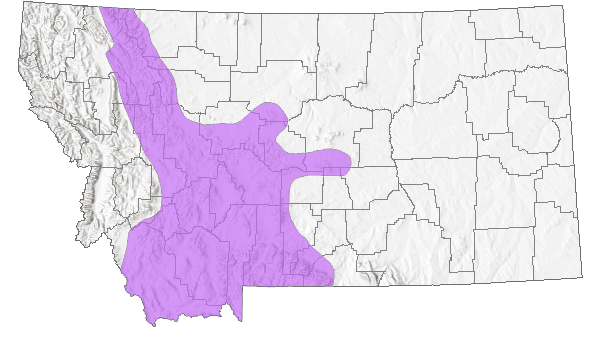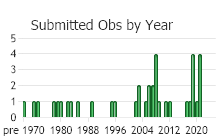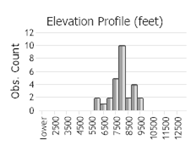View in other NatureServe Network Field Guides
NatureServe
Montana
Utah
Wyoming
Idaho
Wisconsin
British Columbia
South Carolina
Yukon
California
New York
Rocky Mountain Twinpod - Physaria saximontana var. dentata
Other Names:
Physaria saximontana ssp. dentata
State Rank Reason (see State Rank above)
State endemic known from several counties across central and southern Montana mountain ranges.
- Details on Status Ranking and Review
Population Size
Score1 - Moderate: Generally 10,000-100,000 individuals.
CommentPopulation size likely >10,000 individuals though precise population data are lacking.
Range Extent
Score2 - Regional or State Endemic or Small Montana Range: Generally restricted to an area <100,000 sq. miles (equivalent to 2/3 the size of Montana or less) or Montana contributes 50% or more of the species’ range or populations OR limited to 2-3 Sub-basins in Montana.
Area of Occupancy
Score1 - Moderate: Generally occurring in 11-25 Subwatersheds (6th Code HUC’s).
Environmental Specificity
Score1 - Moderate: Species is restricted to a specific habitat that is more widely distributed or to several restricted habitats and is typically dependent upon relatively unaltered, good-quality habitat (C Values of 5-7).
Trends
Score0-1 - Stable to Minor Declines:
CommentTrends are undocumented, though populations are likely stable or experiencing only minor declines as the species often occurs in remote, rocking habitats.
Threats
Score0-1 - Low to Medium.
Intrinsic Vulnerability
Score0-1 - Low to Moderate Vulnerability.
Raw Conservation Status Score
Score
5 to 8 total points scored out of a possible 19.
General Description
Stems ascending to prostrate, 3–10 cm from a simple caudex clothed in old leaf bases. Basal leaves 15–40 mm long; the blades orbicular to rhombic, deeply few-toothed or lyrate. Stem leaves oblanceolate to spatulate, entire. Vestiture of dense, stellate hairs with branched stellae. Petals 8–12 mm long. Fruit of 2 ovate lobes, inflated, 7–11 mm high, the apical sinus deep, the basal sinus absent; style 5–7 mm long; seeds 2 per locule; pedicels spreading, straight to curved, 5–10 mm long. Our plants are subspecies
dentata (Rollins) O'Kane (
Lesica et al. 2012. Manual of Montana Vascular Plants. BRIT Press. Fort Worth, TX).
Phenology
Flowering and fruiting in June and July with fruits maturing into August.
Diagnostic Characteristics
Only variety
dentata occurs in Montana. Variety
saximontana, which is only known from Wyoming, can be distinguished by its entire basal/rosette leaves and longer styles (3 or more times the length of the replum) vs. the toothed apical margins of the basal/rosette leaves of variety
dentata and the shorter styles (1-2 times or less the length of the replum). Another species occurring in southwest Montana is
P. didymocarpa, which differs in having deep sinuses at both the top and bottom of the fruit. The fruit of
P. saximontana is notched with only a sinus at the top.
Rocky Mountain Twinpod –
Physaria saximontana var.
dentata, SOC
*Pedicels are spreading to straight to curved, 5–10 mm long.
*Fruits are inflated
and obviously 2-lobed, 7-11 mm high.
*Basal leaf blades are orbicular to rhombic in shape, 15–40 mm long, and deeply few-toothed or lyrate.
*Plants typically grow in limestone-derived soils of grasslands and fellfields on exposed slopes in the montane zone.
Thick-leaf Bladderpod –
Physaria pachyphylla, SOC
*Fruiting pedicels curve upwards (ascend), are 3-10 mm long, and less than 2 times longer than fruit.
*Fruits inflated, narrowly elliptic to globose (
not obviously appearing 2-lobed), and 3-6 mm tall. Style is 1-3 mm long, shorter than the mature fruit (silicle).
*Basal leaves have distinct petioles and blades. Basal blades are oblanceolate to orbicular in shape, nearly 1 mm thick, and cupped (
not folded).
*Plants grow on white to pinkish, limestone and gypsum soils on exposed ridges and slopes in the valley zone.
Species Range
Montana Range
Range Descriptions

 Native
Native
Range Comments
Montana endemic. Scattered across several counties in the central and western parts of the state.
Observations in Montana Natural Heritage Program Database
Number of Observations: 44
(Click on the following maps and charts to see full sized version)
Map Help and Descriptions
Relative Density

Recency



 (Observations spanning multiple months or years are excluded from time charts)
(Observations spanning multiple months or years are excluded from time charts)
Habitat
Typically found in limestone-derived talus, fellfields, and gravelly slopes at moderate to high elevations.
National Vegetation Classification System Groups Associated with this Species
Alpine
Alpine - Sparse and Barren
Alpine - Vegetated
Sparse and Barren
Sparse and Barren
Stewardship Responsibility
Threats or Limiting Factors
STATE THREAT SCORE REASON
Threat impact not assigned because threats are not known (MTNHP Threat Assessment 2021).
References
- Literature Cited AboveLegend:
 View Online Publication
View Online Publication Lesica, P., M.T. Lavin, and P.F. Stickney. 2012. Manual of Montana Vascular Plants. Fort Worth, TX: BRIT Press. viii + 771 p.
Lesica, P., M.T. Lavin, and P.F. Stickney. 2012. Manual of Montana Vascular Plants. Fort Worth, TX: BRIT Press. viii + 771 p. MTNHP Threat Assessment. 2021. State Threat Score Assignment and Assessment of Reported Threats from 2006 to 2021 for State-listed Vascular Plants. Botany Program, Montana Natural Heritage Program, Helena, Montana.
MTNHP Threat Assessment. 2021. State Threat Score Assignment and Assessment of Reported Threats from 2006 to 2021 for State-listed Vascular Plants. Botany Program, Montana Natural Heritage Program, Helena, Montana.
- Additional ReferencesLegend:
 View Online Publication
View Online Publication
Do you know of a citation we're missing? Lesica, P., M.T. Lavin, and P.F. Stickney. 2022. Manual of Montana Vascular Plants, Second Edition. Fort Worth, TX: BRIT Press. viii + 779 p.
Lesica, P., M.T. Lavin, and P.F. Stickney. 2022. Manual of Montana Vascular Plants, Second Edition. Fort Worth, TX: BRIT Press. viii + 779 p. Mincemoyer, S. 2005. Surveys of significant plant resources and related vegetation types for the Butte Office of the Bureau of Land Management. Montana Natural Heritage Program, Helena, MT. 11 pp + appendices.
Mincemoyer, S. 2005. Surveys of significant plant resources and related vegetation types for the Butte Office of the Bureau of Land Management. Montana Natural Heritage Program, Helena, MT. 11 pp + appendices. Rollins, R. C. 1984. Studies in the Cruciferae of western North America II. Contributions Gray Herbarium 214:1-18.
Rollins, R. C. 1984. Studies in the Cruciferae of western North America II. Contributions Gray Herbarium 214:1-18. Rollins, R. C. 1993. The Cruciferae of Continental North America: systematics of the mustard family from the Arctic to Panama. Stanford University Press, Stanford, California. 976 pp.
Rollins, R. C. 1993. The Cruciferae of Continental North America: systematics of the mustard family from the Arctic to Panama. Stanford University Press, Stanford, California. 976 pp.
- Web Search Engines for Articles on "Rocky Mountain Twinpod"





